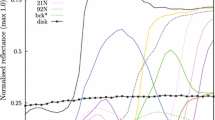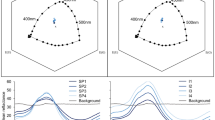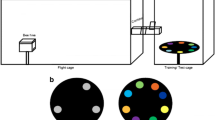Abstract
The colour vision of bees has been extensively analysed in honeybees and bumblebees, but few studies consider the visual perception of stingless bees (Meliponini). In a five-stage experiment the preference for colour intensity and purity, and the preference for the dominant wavelength were tested by presenting four colour stimuli in each test to freely flying experienced workers of two stingless bee species, Melipona mondury and Melipona quadrifasciata. The results with bee-blue, bee-UV-blue and bee-green colours offered in four combinations of varying colour intensity and purity suggest a complex interaction between these colour traits for the determination of colour choice. Specifically, M. mondury preferred bee-UV-blue colours over bee-green, bee-blue and bee-blue-green colours while M. quadrifasciata preferred bee-green colour stimuli. Moreover in M. mondury the preferences were different if the background colour was changed from grey to green. There was a significant difference between species where M. mondury preferred UV-reflecting over UV-absorbing bee-blue-green colour stimuli, whereas M. quadrifasciata showed an opposite preference. The different colour preferences of the free flying bees in identical conditions may be caused by the bees’ experience with natural flowers precedent to the choice tests, suggesting reward partitioning between species.





Similar content being viewed by others
References
Avarguès-Weber A, d’Amaro D, Metzler M, Dyer AG (2014) Conceptualization of relative size by honeybees. Front Behav Neurosci 8:80
Backhaus W (1991) Color opponent coding in the visual system of the honeybee. Vis Res 31:1381–1397
Barth FG, Hrncir M, Jarau S (2008) Signals and cues in the recruitment behaviour of stingless bees (Meliponini). J Comp Physiol A 194:313–327
Bates D, Maechler M, Bolker B (2011) lme4: linear mixed-effect models using S4 classes. R package version 0.999375-42. http://CRAN.R-project.org/package=lme4
Batra SWT (1995) Bees and pollination in our changing environment. Apidologie 26:361–370
Bergamo PJ, Rech AR, Brito VL, Sazima M (2015) Flower colour and visitation rates of Costus arabicus support the ‘bee avoidance’ hypothesis for red-reflecting hummingbird-pollinated flowers. Funct Ecol 30:710–720
Bispo dos Santos SA, Roselino AC, Hrncir M, Bego LR (2009) Pollination of tomatoes by the stingless bee Melipona quadrifasciata and the honey bee Apis mellifera (Hymenoptera, Apidae). Genet Mol Res 8:751–757
Briscoe AD, Chittka L (2001) The evolution of color vision in insects. Annu Rev Entomol 46:471–510
Chittka L (1992) The colour hexagon: a chromaticity diagram based on photoreceptor excitation as a generalized representation of colour opponency. J Comp Physiol A 170:533–543
Chittka L (1994) Ultraviolet as a component of flower reflections, and the colour perception of Hymenoptera. Vis Res 34:1489–1508
Chittka L (1996) Optimal sets of color receptors and color opponent systems for coding of natural objects in insect vision. J Theor Biol 181:179–196
Chittka L, Menzel R (1992) The evolutionary adaptation of flower colors and the insect pollinators’ color vision systems. J Comp Physiol A 171:171–181
Chittka L, Raine NE (2006) Recognition of flowers by pollinators. Curr Opin Plant Biol 9:428–435
Cnaani J, Thomson JD, Papaj DR (2006) Flower choice and learning in foraging bumblebees: effects of variation in nectar volume and concentration. Ethology 112:278–285
Daumer K (1956) Reizmetrische Untersuchungen des Farbensehens der Bienen. Z Vergl Physiol 38:413–478
Daumer K (1958) Blumenfarben, wie sie Bienen sehen. Z Vergl Physiol 41:49–110
Dyer AG, Chittka L (2004) Fine colour discrimination requires differential conditioning in bumblebees. Naturwissenschaften 91:224–227
Dyer AG, Whitney HM, Arnold SEJ, Glover BJ, Chittka L (2007) Mutations perturbing petal cell shape and anthocyanin synthesis influence bumblebee perception of Antirrhinum majus flower colour. Arthropod Plant Interact 1:45–55
Dyer AG, Spaethe J, Prack S (2008) Comparative psychophysics of bumblebee and honeybee colour discrimination and object detection. J Comp Physiol A 194:617–627
Dyer AG, Boyd-Gerny S, McLoughlin S, Rosa MG, Simonov V, Wong BB (2012) Parallel evolution of angiosperm colour signals: common evolutionary pressure linked to hymenopteran vision. Proc R Soc Lond B 279:3606–3615
Dyer AG, Boyd-Gerny S, Shrestha M, Lunau K, Garcia JE, Koethe S, Wong BBM (2016) Innate colour preferences of the Australian native stingless bee Tetragonula carbonaria Sm. J Comp Physiol A. doi:10.1007/s00359-016-1101-4
Giurfa M (2004) Conditioning procedure and color discrimination in the honeybee Apis mellifera. Naturwissenschaften 91:228–231
Giurfa M, Lehrer M (2001) Honeybee vision and floral displays: from detection to close-up recognition. In: Chittka L, Thomson JD (eds) Cognitive ecology of pollination. Cambridge University Press, Cambridge, pp 61–82
Giurfa M, Núñez J, Chittka L, Menzel R (1995) Colour preferences of flower-naive honeybees. J Comp Physiol A 177:247–259
Giurfa M, Vorobyev M, Kevan P, Menzel R (1996) Detection of coloured stimuli by honeybees: minimum visual angles and receptor specific contrasts. J Comp Physiol A 178:699–709
Giurfa M, Vorobyev M, Brandt R, Posner B, Menzel R (1997) Discrimination of coloured stimuli by honeybees: alternative use of achromatic and chromatic signals. J Comp Physiol A 180:235–243
Gumbert A (2000) Color choices by bumblebees (Bombus terrestris): innate preferences and generalization after learning. Behav Ecol Sociobiol 48:36–43
Heard T (1994) Behaviour and pollinator efficiency of stingless bees and honey bees on macadamia flowers. J Apicult Res 33:191–198
Heard TA (1999) The role of stingless bees in crop pollination. Annu Rev Entomol 44:183–206
Heard T, Dollin A (1998) Crop pollination with Australian stingless bees. Nat Bees Aust Ser 6:1–17
Hempel de Ibarra N, Vorobyev M, Brandt R, Giurfa M (2000) Detection of bright and dim colours by honeybees. J Exp Biol 203:3289–3298
Hempel de Ibarra N, Vorobyev M, Menzel R (2014) Mechanisms, functions and ecology of colour vision in the honeybee. J Comp Physiol A 200:411–433
Hikawa M, Myanaga R (2009) Effects of pollination by Melipona quadrifasciata (Hymenoptera: Apidae) on tomatoes in protected culture. Appl Entomol Zool 44:301–307
Hill PSM, Wells PH, Wells H (1997) Spontaneous flower constancy and learning in honeybees as a function of colour. Anim Behav 54:15–627
Horridge A (2005) What the honeybee sees: a review of recognition system of Apis mellifera. Physiol Entomol 30:2–13
Horridge A (2007) The preference of the honeybee (Apis mellifera) for different visual cues during the learning process. J Insect Physiol 53:877–889
Hubbell SP, Johnson LK (1977) Competition and nest spacing in a tropical stingless bee community. Ecology 58:949–963
Hudon T, Plowright C (2011) Trapped: assessing attractiveness of potential food sources to bumblebees. J Insect Behav 24:44–158
Ings TC, Raine NE, Chittka L (2009) A population comparison of the strength and persistence of innate colour preferences and learning speed in the bumblebee Bombus terrestris. Behav Ecol Sociobiol 63:1207–1218
Jarau S, Hrncir M, Zucchi R, Barth FG (2000) Recruitment behaviour in stingless bees, Melipona scutellaris and M. quadrifasciata. I. Foraging at food sources differing in direction and distance. Apidologie 31:81–91
Jarau S, Hrncir M, Schmidt VM, Zucchi R, Barth FG (2003) Effectiveness of recruitment behaviour in stingless bees (Apidae, Meliponini). Insect Soc 50:365–374
Jarau S, Hrncir M, Zucchi R, Barth FG (2004) A stingless bee uses labial gland secretions for scent trail communication (Trigona recursa Smith 1863). J Comp Physiol A 190:233–239
Kemp DJ, Herberstein ME, Fleishman LJ, Endler JA, Bennett AT, Dyer AG, Hart NS, Marshall J, Whiting MJ (2016) An integrative framework for the appraisal of coloration in nature. Am Nat 185:705–724. doi:10.1086/681021
Kerr WE, Nielsen RA (1966) Evidence that genetically determined Melipona queens can become workers. Genetics 54:859–866
Klein AM, Vaissiere BE, Cane JH, Steffan-Dewenter I, Cunningham SA, Kremen C, Tscharntke T (2007) Importance of pollinators in changing landscapes for world crops. Proc R Soc Lond B 274:303–313
Laughlin SB (1981) Neural principles in the peripheral visual systems of invertebrates. In: Autrum H (ed) Handbook of sensory physiology, vol VII/6B. Springer, Berlin, pp 135–280
Laughlin SB (1989) The role of sensory adaptation in the retina. J Exp Biol 146:39–62
Lehrer M, Bischof S (1995) Detection of model flowers by honeybees: the role of chromatic and achromatic contrast. Naturwissenschaften 82:145–147
Lehrer M, Horridge GA, Zhang SW, Gadagkar R (1995) Shape vision in bees: innate preference for flower-like patterns. Philos Trans R Soc Lond Ser B 347:123–137
Luebbe E (2013) Experimental evidence of the formula of saturation. J Phys Sci Appl 3:79–81
Lunau K (1990) Colour saturation triggers innate reactions to flower signals: flower dummy experiments with bumblebees. J Comp Physiol A 166:827–834
Lunau K (1992) A new interpretation of flower guide colouration: absorption of ultraviolet light enhances colour saturation. Plant Syst Evol 183:51–65
Lunau K, Maier EJ (1995) Innate colour preference of flower visitors. J Comp Physiol A 177:1–19
Lunau K, Wacht S, Chittka L (1996) Colour choices of naïve bumblebees and their implications for colour perception. J Comp Physiol A 178:477–489
Lunau K, Papiorek S, Eltz T, Sazima M (2011) Avoidance of achromatic colours by bees provides a private niche for hummingbirds. J Exp Biol 214:1607–1612
Lynn SK, Cnaani J, Papaj DR (2005) Peak shift discrimination learning as mechanism of signal evolution. Evolution 59:1300–1305
Marden JH, Waddington KD (1981) Floral choices by honeybees in relation to the relative distance to flowers. Physiol Entomol 6:431–435
Menzel R (1967) Untersuchungen zum Erleben von Spektralfarben durch Honigbienen (Apis mellifera). Z Vergl Physiol 56:22–62
Morawetz L, Svoboda A, Spaethe J, Dyer AG (2013) Blue colour preference in honeybees distracts visual attention for learning closed shapes. J Comp Physiol A 199:817–827
Nieh J (2004) Recruitment communication in stingless bees (Hymenoptera, Apidae, Meliponini). Apidologie 35:159–182
Papiorek S, Rohde K, Lunau K (2013) Bees’ subtle colour preferences: how bees respond to small changes in pigment concentration. Naturwissenschaften 100:633–643
Peitsch D, Fietz A, Hertel H, de Souza J, Ventura DF, Menzel R (1992) The spectral input systems of hymenopteran insects and their receptor-based colour vision. J Comp Physiol A 170:23–40
Potts SG, Biesmeijer JC, Kremen C, Neumann P, Schweiger O, Kunin WE (2010) Global pollinator declines: trends, impacts and drivers. Trends Ecol Evol 25:345–353
R Development Core Team (2008) R: A language and environment for statistical computing. R Foundation for Statistical Computing, Vienna, Austria
Raguso RA (2008) Wake up and smell the roses: the ecology and evolution of floral scent. Annu Rev Ecol Evol Syst 39:549–569
Raine NE, Chittka L (2007) Flower constancy and memory dynamics in bumblebees (Hymenoptera: Apidae: Bombus). Entomol Gener 29:179–199
Reader T, Higginson AD, Barnard CJ, Gilbert FS (2006) The effect of predation risk from crab spiders on bee foraging behavior. Behav Ecol 17:933–939
Rhode K, Papiorek S, Lunau K (2013) Bumblebees (Bombus terrestris) and honeybees (Apis mellifera) prefer similar colours of high spectral purity over trained colours. J Comp Physiol A 199:197–210
Rodriguez-Gironés MA, Santamaría L (2004) Why are so many bird flowers red? PLoS Biol 10:1515–1519
Roubik DW (1982) The ecological impact of nectar-robbing bees and pollinating hummingbirds on a tropical shrub. Ecology 63:354–360
Sánchez D, Vandame R (2012) Color and shape discrimination in the stingless bee Scaptotrigona mexicana Gúerin (Hymenoptera, Apidae). Neotrop Entomol 41:171–177
Simonds V, Plowright CMS (2004) How do bumblebees first find flowers? Unlearned approach responses and habituation. Anim Behav 67:379–386
Slaa ED, Chaves LAS, Malagodi-Braga KS, Hofstede FE (2006) Stingless bees in applied pollination: practice and perspectives. Apidologie 37:293–315
Spaethe J, Tautz J, Chittka L (2001) Visual constraints in foraging bumblebees: flower size and color affect search time and flight behaviour. Proc Nat Acad Sci USA 98:3898–3903
Spaethe J, Streinzer M, Eckert J, May S, Dyer AG (2014) Behavioural evidence of colour vision in free flying stingless bees. J Comp Physiol A 200:485–496
Srinivasan MV, Lehrer M (1984) Temporal acuity of honeybee vision-behavioural studies using moving stimuli. J Comp Physiol A 155:297–312
Telles FJ, Rodríguez-Gironés M (2015) Insect vision models under scrutiny: what bumblebees (Bombus terrestris terrestris L.) can still tell us. Sci Nat 102:4. doi:10.1007/s00114-014-1256-1 (Epub 2015 Jan 23)
Valido A, Schaeffer HM, Jordano P (2011) Colour, design and reward: phenotypic integration of fleshy fruit displays. J Evol Biol 24:751–760
Viana JL, De Abreu Cerqueira Sousa H, De Oliveira Alves RM, Pereira DG, Silva JC, Da Paixáo JF, Waldschmidt AM (2015) Bionomics of Melipona mondury Smith 1863 (Hymenoptera: Apidae, Meliponini) in relation to its nesting behaviour. Biota Neotropica 15(3):1–7
Von Frisch K (1967) The dance language and orientation of bees. Harvard University Press, Cambridge
Vorobyev M, Brandt R (1997) How do insect pollinators discriminate colors? Isr J Plant Sci 45:103–113
Ackno wledgments
We thank Gabriel AR Melo from the Universidade Federal do Paraná, Curitiba, Brazil and Laércio P Amaral-Neto from the Universidade Federal do Paraná, Curitiba, Brazil for supplying native stingless bee hives and providing support during our experiments. Furthermore, JB thanks the Heinrich-Heine-University, Düsseldorf, Germany for funding her trip to Curitiba, Brazil by granting a Wolters-Vollhardt scholarship. SK and KL thank the DFG (Deutsche Forschungsgemeinschaft) for funding. AGD is grateful to the Alexander von Humboldt foundation for facilitating collaborative research. At last, we would like to thank Stefan Jarau from the University of Ulm, Germany; Miguel A Rodríguez-Gironés from the Spanish National Research Council in Madrid, Spain; and an anonymous reviewer for critical and helpful discussion.
Author information
Authors and Affiliations
Corresponding author
Ethics declarations
Conflict of interest
The authors declare that they have no competing interests.
Ethical approval
All applicable international, national, and/or institutional guidelines for the care and use of animals were followed.
Electronic supplementary material
Below is the link to the electronic supplementary material.
359_2016_1115_MOESM1_ESM.tif
Colour loci of the test stimuli of stage I-IV with green background in the colour hexagon (Chittka 1992) with calculated values of the receptor-specific contrast, chromatic contrast, spectral purity and green contrast. (TIFF 8382 kb)
359_2016_1115_MOESM2_ESM.tif
Colour preferences of Melipona mondury tested with colour stimuli presented against green background. The colour choices of the tested bees (n = 20) are plotted against the tested stimuli for every test stage. Workers were tested for bee-blue (stage I), bee-UV-blue (stage II), bee-green (stage III), and bee-blue-green (stage IV) colours. Subsequently the workers were tested for the most preferred colour hue (stage V). Each stage comprised four colours of the same dominant wavelength which varied in colour intensity and colour purity to test the impact of these two colour traits on the bees’ colour choice. I = colour intensity, P = colour purity; * = low, ** = medium, *** = high; UV- = ultraviolet-absorbing; UV + = ultraviolet-reflecting. Different letters indicate significant differences, n.s. = not significant (Tukey all-pair comparisons) (TIFF 36732 kb)
359_2016_1115_MOESM3_ESM.tif
Weighted colour preferences of individual bees of M. mondury (black bars) and M. quadrifasciata (shaded bars) for the five tested stages. The mean choice frequency of each individual bee were weighted with the most frequently visited stimulus scored 1 and the other three stimuli scored 0. I = colour intensity, P = colour purity; * = low, ** = medium, *** = high; UV- = ultraviolet-absorbing; UV + = ultraviolet-reflecting; the symbols above the columns represent the statistical analysis by Fisher’s exact test: *** = p < 0.001, ** = p < 0.01 (TIFF 29870 kb)
Rights and permissions
About this article
Cite this article
Koethe, S., Bossems, J., Dyer, A.G. et al. Colour is more than hue: preferences for compiled colour traits in the stingless bees Melipona mondury and M. quadrifasciata . J Comp Physiol A 202, 615–627 (2016). https://doi.org/10.1007/s00359-016-1115-y
Received:
Revised:
Accepted:
Published:
Issue Date:
DOI: https://doi.org/10.1007/s00359-016-1115-y




